m (Saved using "Save and continue" button in form) |
(update property name) |
||
| (15 révisions intermédiaires par 3 utilisateurs non affichées) | |||
| Ligne 1 : | Ligne 1 : | ||
| − | {{ | + | {{Tuto Details |
|Type=Creation | |Type=Creation | ||
|Area=Food and Agriculture | |Area=Food and Agriculture | ||
|Tags=potato, tower, garden, organic, permaculture | |Tags=potato, tower, garden, organic, permaculture | ||
| − | |Description=Use locally-available material, simple technics and tools to build Potato Towers to: | + | |Description=<translate><!--T:1--> |
| + | Use locally-available material, simple technics and tools to build Potato Towers to: | ||
*Harvest a high yield of potatoes on a very limited surface, | *Harvest a high yield of potatoes on a very limited surface, | ||
*Lower potato watering effort (if needed), | *Lower potato watering effort (if needed), | ||
*Lower potato harvesting effort, | *Lower potato harvesting effort, | ||
*Bring foods closer to the kitchen, | *Bring foods closer to the kitchen, | ||
| − | *Inspire people through attractive green design. | + | *Inspire people through attractive green design.</translate> |
|Difficulty=Easy | |Difficulty=Easy | ||
|Cost=0 | |Cost=0 | ||
|Currency=EUR (€) | |Currency=EUR (€) | ||
| − | |Duration=1 | + | |Duration=1,5 |
|Duration-type=hour(s) | |Duration-type=hour(s) | ||
|Licences=Attribution (CC BY) | |Licences=Attribution (CC BY) | ||
| + | |Main_Picture=Potato_Tower_IMG-20180301-WA0006.jpg | ||
|SourceLanguage=none | |SourceLanguage=none | ||
|Language=en | |Language=en | ||
|IsTranslation=0 | |IsTranslation=0 | ||
}} | }} | ||
| − | {{ | + | {{Introduction |
| − | |Introduction==Acknowledgements= | + | |Introduction=<translate>=Acknowledgements= <!--T:2--> |
The landscape is quite steep at Lake Bunyonyi Ecovillage. Thus, planting in terraces requires important effort to work the ground for potato plantation. Moreover, potato harvesting is also work-intensive as one must dig out the potatoes from the ground. On top of that, the gardens are quite far from the kitchen which adds some effort to the process between collecting and transporting before preparing the food. Finally, the available place between the houses of the ecovillage is limited. | The landscape is quite steep at Lake Bunyonyi Ecovillage. Thus, planting in terraces requires important effort to work the ground for potato plantation. Moreover, potato harvesting is also work-intensive as one must dig out the potatoes from the ground. On top of that, the gardens are quite far from the kitchen which adds some effort to the process between collecting and transporting before preparing the food. Finally, the available place between the houses of the ecovillage is limited. | ||
=Our solution and its expectable benefits= | =Our solution and its expectable benefits= | ||
| Ligne 28 : | Ligne 30 : | ||
*Lower potato harvesting effort, | *Lower potato harvesting effort, | ||
*Bring foods closer to the kitchen, | *Bring foods closer to the kitchen, | ||
| − | *Inspire people through attractive green design. | + | *Inspire people through attractive green design.</translate> |
}} | }} | ||
| − | {{ | + | {{Materials |
| − | |Material=*Parts: | + | |Material=<translate><!--T:3--> |
| + | *Parts: | ||
**(8) Wooden poles (sturdy), | **(8) Wooden poles (sturdy), | ||
**(1*) Pipe (not available on site => we used stones rather than a pipe); | **(1*) Pipe (not available on site => we used stones rather than a pipe); | ||
| Ligne 42 : | Ligne 45 : | ||
**If available, compost, | **If available, compost, | ||
**Water, | **Water, | ||
| − | **Mulching material (corn stalks, rice hulls, hay, straw, dry leaves, BRF …); | + | **Mulching material (corn stalks, rice hulls, hay, straw, dry leaves, BRF …);</translate> |
| − | |Tools=*Tools (see FAQ & Troubleshooting? For other alternatives): | + | |Tools=<translate><!--T:4--> |
| + | *Tools (see FAQ & Troubleshooting? For other alternatives): | ||
**(1) Panga (or machete, axe), | **(1) Panga (or machete, axe), | ||
**(1) Spear (or djembe ), | **(1) Spear (or djembe ), | ||
**(1) Set of bags (or wheelbarrow, bucket) | **(1) Set of bags (or wheelbarrow, bucket) | ||
**(1) Bucket (or arrosoir ) | **(1) Bucket (or arrosoir ) | ||
| − | **(1)°Rope (or tape measurer); | + | **(1)°Rope (or tape measurer);</translate> |
}} | }} | ||
| − | {{ | + | {{Separator}} |
| − | {{ | + | {{Tuto Step |
| − | |Step_Title=How? | + | |Step_Title=<translate><!--T:5--> How?</translate> |
| − | |Step_Content= | + | |Step_Content=<translate></translate> |
| − | |||
| − | |||
| − | |||
| − | |||
| − | |||
| − | |||
| − | |||
}} | }} | ||
| − | {{ | + | {{Tuto Step |
| − | |Step_Title=Gather construction material | + | |Step_Picture_01=Potato_Tower_IMG_20180122_163339.jpg |
| − | |Step_Content=#Select sturdy eucalyptus tree trunks for poles, | + | |Step_Title=<translate><!--T:6--> Gather construction material</translate> |
| + | |Step_Content=<translate><!--T:7--> | ||
| + | #Select sturdy eucalyptus tree trunks for poles, | ||
#Use the panga to cut down the trunks, | #Use the panga to cut down the trunks, | ||
#Use the panga to remove the branches from the poles, | #Use the panga to remove the branches from the poles, | ||
| Ligne 78 : | Ligne 77 : | ||
{{Info|If you did not collect enough wood sticks, you can later gather more branches and/or use other available material as flexible wood sticks.}} | {{Info|If you did not collect enough wood sticks, you can later gather more branches and/or use other available material as flexible wood sticks.}} | ||
{{Info|If you did not collect enough banana leaves, you can later gather more leaves and/or use other available material as envelope.}} | {{Info|If you did not collect enough banana leaves, you can later gather more leaves and/or use other available material as envelope.}} | ||
| − | {{Info|We describe the procedure as implemented at Lake Bunyonyi; please feel free to adapt in accordance with your environment!}} | + | {{Info|We describe the procedure as implemented at Lake Bunyonyi; please feel free to adapt in accordance with your environment!}}</translate> |
}} | }} | ||
| − | {{ | + | {{Tuto Step |
| − | |Step_Title=Define the location where you want to install your potato tower | + | |Step_Title=<translate><!--T:8--> Define the location where you want to install your potato tower</translate> |
| − | |Step_Content= | + | |Step_Content=<translate></translate> |
}} | }} | ||
| − | {{ | + | {{Tuto Step |
| − | |Step_Title=Carry construction material to the location | + | |Step_Title=<translate><!--T:9--> Carry construction material to the location</translate> |
| − | |Step_Content= | + | |Step_Content=<translate></translate> |
}} | }} | ||
| − | {{ | + | {{Tuto Step |
| − | |Step_Title=Prepare the location | + | |Step_Picture_00=Potato_Tower_IMG_20180122_165754.jpg |
| − | |Step_Content=#If necessary, make the location flat before you install the potato tower, | + | |Step_Title=<translate><!--T:10--> Prepare the location</translate> |
| + | |Step_Content=<translate><!--T:11--> | ||
| + | #If necessary, make the location flat before you install the potato tower, | ||
#Place one of the collected stick at the center of the location, | #Place one of the collected stick at the center of the location, | ||
#Insert the stick in the ground, | #Insert the stick in the ground, | ||
| Ligne 103 : | Ligne 104 : | ||
##Stow the rope; | ##Stow the rope; | ||
{{Info|Lake Bunyonyi Ecovillage has many slopes. We built a first structure to have a flat location (see picture).}} | {{Info|Lake Bunyonyi Ecovillage has many slopes. We built a first structure to have a flat location (see picture).}} | ||
| − | {{Info|Those steps are really for the aesthetics. The rope allows you to have a circle shape. We did not do it.}} | + | {{Info|Those steps are really for the aesthetics. The rope allows you to have a circle shape. We did not do it.}}</translate> |
| + | }} | ||
| + | {{Tuto Step | ||
| + | |Step_Picture_00=Potato_Tower_IMG_20180122_174516.jpg | ||
| + | |Step_Title=<translate><!--T:12--> Install the poles</translate> | ||
| + | |Step_Content=<translate><!--T:13--> | ||
| + | {{Dont|As you dig, do NOT discard the soil / dirt you remove; keep the soil / dirt you remove available to install the poles.}} | ||
| + | #Select a stick, | ||
| + | #Remove the stick from the ground, | ||
| + | #Use the spear to dig a one-feet \ 30-cm deep hole where the stick was, | ||
| + | #Install the pole inside the hole, | ||
| + | #Fill the hole with stones and the soil / dirt you removed, | ||
| + | #Repeat seven times (one for each remaining pole);</translate> | ||
| + | }} | ||
| + | {{Tuto Step | ||
| + | |Step_Title=<translate><!--T:14--> Weave the flexible wood sticks between the poles to create a mesh</translate> | ||
| + | |Step_Content=<translate><!--T:15--> | ||
| + | {{Info|Feel free to leave up to 8” \ 20 cm gap between each mesh layer / layer of waving.}} | ||
| + | {{Info|As far as possible, alternate inside / outside on each pole. It should look like a “big basket” at the end.}}</translate> | ||
| + | }} | ||
| + | {{Tuto Step | ||
| + | |Step_Title=<translate><!--T:16--> Collect the planting material</translate> | ||
| + | |Step_Content=<translate><!--T:17--> | ||
| + | #If necessary, collect the stones (see ''"Gather construction material"''), | ||
| + | #Collect the potato eyes, | ||
| + | #Collect the soil, | ||
| + | #If available, collect the compost or other organic fertilizer solution you want to use for your potatoes, | ||
| + | #If necessary and possible, already collect mulching material (corn stalks, rice hulls, hay, straw, dry leaves, BRF …);</translate> | ||
}} | }} | ||
| − | {{ | + | {{Tuto Step |
| − | |Step_Title= | + | |Step_Title=<translate><!--T:18--> Carry planting material to the location</translate> |
| − | |Step_Content= | + | |Step_Content=<translate></translate> |
}} | }} | ||
| − | {{ {{ | + | {{Tuto Step |
| − | | | + | |Step_Picture_00=Potato_Tower_IMG_20180122_173444.jpg |
| − | | | + | |Step_Picture_01=Potato_Tower_IMG_20180122_173327.jpg |
| + | |Step_Picture_02=Potato_Tower_IMG_20180122_180642.jpg | ||
| + | |Step_Title=<translate><!--T:19--> Build your potato tower</translate> | ||
| + | |Step_Content=<translate><!--T:20--> | ||
| + | {{Dont|Do NOT let uncovered spaces around the potato tower. Even though potato leaves love the sun, the potatoes themselves might not be edible if the potatoes are in direct contact with the sun. Make sure that your banana leave envelope fills the gaps around the potato tower.}} | ||
| + | {{Dont|Do NOT always add potatoes on top of each other in the different layers. Potatoes will use the space available for them to grow. If you plant them one on top of each other, you might limit their development and size. On each layer, alternate the spot where you plant the potato eyes.}} | ||
| + | #Add stones in the center of the potato tower, | ||
| + | #Add a layer of banana leaves inside the structure of the potato tower, | ||
| + | #If necessary, mix the soil and the compost, | ||
| + | #Add the mix in the structure of the potato tower, between the banana leaves and the stones, | ||
| + | #Add the potato eyes: | ||
| + | ##Add two or three potato eyes approximately 4” \ 10 cm from the outer part of the potato tower (from the banana leaves), | ||
| + | ##Repeat approximately 8” \ 20 cm from the previous plantation spot, | ||
| + | ##Repeat until you complete the circle; | ||
| + | #Repeat the two steps above until you reach the top of the banana leaves on this layer, | ||
| + | #Repeat steps above until you reach the top of the potato tower; | ||
| + | {{Info|Stones will allow the water to flow from the top to the bottom of the potato tower. This irrigation trick will keep the soil moist inside the potato tower; the potatoes will thank you for that one. Some use a pipe with holes.}} | ||
| + | {{Info|Banana leaves (or newspaper) are thin enough for the potato to understand the shortest way to catch the sun and let the stems pierce through. The banana leaves are also sturdy enough to hold the soil inside the tower; for newspaper, you might want a thinner mesh than the one we propose here.}} | ||
| + | {{Info|Feel free to plant other crops on top of your potato tower! Think about how long those crops will need to grow; if it takes the same amount of the time as the potatoes, go for it! | ||
| + | We planted beans on the side and on top of the potato tower to have a better yield.}}</translate> | ||
}} | }} | ||
| − | {{ {{ | + | {{Tuto Step |
| − | |Step_Title= | + | |Step_Title=<translate><!--T:21--> If necessary, collect mulching material (corn stalks, rice hulls, hay, straw, dry leaves, BRF …)</translate> |
| − | |Step_Content= | + | |Step_Content=<translate></translate> |
| − | + | }} | |
| − | + | {{Tuto Step | |
| − | + | |Step_Title=<translate><!--T:22--> Install mulching material on top of your potato tower</translate> | |
| − | # | + | |Step_Content=<translate><!--T:23--> {{Info|Mulch will keep your soil moist and protect the microorganisms you incorporated with your soil (among other very cool things mulch does... mulch! mulch! mulch!).}}</translate> |
| − | # | + | }} |
| − | + | {{Tuto Step | |
| − | # | + | |Step_Picture_00=Potato_Tower_IMG_20180122_182804.jpg |
| − | # | + | |Step_Title=<translate><!--T:24--> Water!</translate> |
| − | # | + | |Step_Content=<translate><!--T:25--> |
| − | + | #Use a bucket to fetch water, | |
| − | ## | + | #Pour the water on the stones in the centre of the potato tower, |
| − | + | #Use a bucket to fetch water, | |
| − | {{ | + | #Pour the water on the potato tower, |
| + | #If necessary, repeat;</translate> | ||
| + | }} | ||
| + | {{Tuto Step | ||
| + | |Step_Picture_00=Potato_Tower_IMG_20180122_182447.jpg | ||
| + | |Step_Picture_01=Potato_Tower_IMG-20180301-WA0006.jpg | ||
| + | |Step_Title=<translate><!--T:26--> Let it grow</translate> | ||
| + | |Step_Content=<translate></translate> | ||
| + | }} | ||
| + | {{Tuto Step | ||
| + | |Step_Picture_00=Potato_Tower_index.jpg | ||
| + | |Step_Picture_01=Potato_Tower_index1.jpg | ||
| + | |Step_Title=<translate><!--T:27--> Harvest</translate> | ||
| + | |Step_Content=<translate><!--T:28--> | ||
| + | #Remove the poles, | ||
| + | #Collect the potatoes from the ruins of your tower, | ||
| + | #Use the soil in your garden;</translate> | ||
| + | }} | ||
| + | {{Tuto Step | ||
| + | |Step_Title=<translate><!--T:29--> Enjoy your meals</translate> | ||
| + | |Step_Content=<translate></translate> | ||
}} | }} | ||
| − | {{ | + | {{Notes |
| − | | | + | |Notes=<translate><!--T:30--> |
| − | + | Please share with us with your remarks, comments, improvements, achievements, etc. and whatever the space available, feel free to grow potatoes! | |
| + | |||
| + | <!--T:31--> | ||
| + | Learn more about our projects: https://sustainable-autonomy.weebly.com/ | ||
| + | |||
| + | <!--T:32--> | ||
| + | Read about our volunteering in Lake Bunyonyi, Uganda : https://lakebunyonyi.wixsite.com/ecovillage | ||
| + | |||
| + | <!--T:33--> | ||
| + | Follow us: Twitter logo => https://twitter.com/Sustainomy/</translate> | ||
}} | }} | ||
| − | {{ | + | {{Tuto Status |
| − | | | + | |Complete=Published |
}} | }} | ||
| − | |||
Version actuelle datée du 9 décembre 2019 à 12:51
- Harvest a high yield of potatoes on a very limited surface,
- Lower potato watering effort (if needed),
- Lower potato harvesting effort,
- Bring foods closer to the kitchen,
- Inspire people through attractive green design.
Sommaire
[masquer]- 1 Introduction
- 2 Acknowledgements
- 3 Our solution and its expectable benefits
- 3.1 Étape 1 - How?
- 3.2 Étape 2 - Gather construction material
- 3.3 Étape 3 - Define the location where you want to install your potato tower
- 3.4 Étape 4 - Carry construction material to the location
- 3.5 Étape 5 - Prepare the location
- 3.6 Étape 6 - Install the poles
- 3.7 Étape 7 - Weave the flexible wood sticks between the poles to create a mesh
- 3.8 Étape 8 - Collect the planting material
- 3.9 Étape 9 - Carry planting material to the location
- 3.10 Étape 10 - Build your potato tower
- 3.11 Étape 11 - If necessary, collect mulching material (corn stalks, rice hulls, hay, straw, dry leaves, BRF …)
- 3.12 Étape 12 - Install mulching material on top of your potato tower
- 3.13 Étape 13 - Water!
- 3.14 Étape 14 - Let it grow
- 3.15 Étape 15 - Harvest
- 3.16 Étape 16 - Enjoy your meals
- 3.17 Notes et références
- 3.18 Commentaires
Introduction
Acknowledgements
The landscape is quite steep at Lake Bunyonyi Ecovillage. Thus, planting in terraces requires important effort to work the ground for potato plantation. Moreover, potato harvesting is also work-intensive as one must dig out the potatoes from the ground. On top of that, the gardens are quite far from the kitchen which adds some effort to the process between collecting and transporting before preparing the food. Finally, the available place between the houses of the ecovillage is limited.
Our solution and its expectable benefits
Use locally-available material, simple technics and tools to build Potato Towers to:
- Harvest a high yield of potatoes on a very limited surface,
- Lower potato watering effort (if needed),
- Lower potato harvesting effort,
- Bring foods closer to the kitchen,
- Inspire people through attractive green design.
Matériaux
- Parts:
- (8) Wooden poles (sturdy),
- (1*) Pipe (not available on site => we used stones rather than a pipe);
- Consumables:
- Flexible wood sticks (or hence fence wire),
- Banana leaves (or newspaper, carton),
- Stones (see *),
- Potato eyes,
- Soil,
- If available, compost,
- Water,
- Mulching material (corn stalks, rice hulls, hay, straw, dry leaves, BRF …);
Outils
- Tools (see FAQ & Troubleshooting? For other alternatives):
- (1) Panga (or machete, axe),
- (1) Spear (or djembe ),
- (1) Set of bags (or wheelbarrow, bucket)
- (1) Bucket (or arrosoir )
- (1)°Rope (or tape measurer);
Étape 1 - How?
Étape 2 - Gather construction material
- Select sturdy eucalyptus tree trunks for poles,
- Use the panga to cut down the trunks,
- Use the panga to remove the branches from the poles,
- Collect the branches to later use them as flexible wood sticks,
- Use the panga to cut the trunks into poles,
- Collect banana leaves,
- Collect stones,
- Collect nine sticks,
- If possible, already collect mulching material (corn stalks, rice hulls, hay, straw, dry leaves, BRF …);
Étape 3 - Define the location where you want to install your potato tower
Étape 4 - Carry construction material to the location
Étape 5 - Prepare the location
- If necessary, make the location flat before you install the potato tower,
- Place one of the collected stick at the center of the location,
- Insert the stick in the ground,
- Define the position of the poles around the stick (circle):
- Attach the rope to the stick,
- Extend the rope 1 to 2 feet \ 0,3 to 0,6 m from the stick,
- Place one of the collected stick at the end of the rope,
- Keep the 1 to 2 feet \ 0,3 to 0,6 m from the stick with the rope and move 1/8-turn around the central stick,
- Place one of the collected stick at the end of the rope,
- Repeat six times (one for each remaining pole),
- Remove the central stick,
- Stow the rope;
Étape 6 - Install the poles
- Select a stick,
- Remove the stick from the ground,
- Use the spear to dig a one-feet \ 30-cm deep hole where the stick was,
- Install the pole inside the hole,
- Fill the hole with stones and the soil / dirt you removed,
- Repeat seven times (one for each remaining pole);
Étape 7 - Weave the flexible wood sticks between the poles to create a mesh
Étape 8 - Collect the planting material
- If necessary, collect the stones (see "Gather construction material"),
- Collect the potato eyes,
- Collect the soil,
- If available, collect the compost or other organic fertilizer solution you want to use for your potatoes,
- If necessary and possible, already collect mulching material (corn stalks, rice hulls, hay, straw, dry leaves, BRF …);
Étape 9 - Carry planting material to the location
Étape 10 - Build your potato tower
- Add stones in the center of the potato tower,
- Add a layer of banana leaves inside the structure of the potato tower,
- If necessary, mix the soil and the compost,
- Add the mix in the structure of the potato tower, between the banana leaves and the stones,
- Add the potato eyes:
- Add two or three potato eyes approximately 4” \ 10 cm from the outer part of the potato tower (from the banana leaves),
- Repeat approximately 8” \ 20 cm from the previous plantation spot,
- Repeat until you complete the circle;
- Repeat the two steps above until you reach the top of the banana leaves on this layer,
- Repeat steps above until you reach the top of the potato tower;
Étape 11 - If necessary, collect mulching material (corn stalks, rice hulls, hay, straw, dry leaves, BRF …)
Étape 12 - Install mulching material on top of your potato tower
Étape 13 - Water!
- Use a bucket to fetch water,
- Pour the water on the stones in the centre of the potato tower,
- Use a bucket to fetch water,
- Pour the water on the potato tower,
- If necessary, repeat;
Étape 15 - Harvest
- Remove the poles,
- Collect the potatoes from the ruins of your tower,
- Use the soil in your garden;
Étape 16 - Enjoy your meals
Notes et références
Please share with us with your remarks, comments, improvements, achievements, etc. and whatever the space available, feel free to grow potatoes!
Learn more about our projects: https://sustainable-autonomy.weebly.com/
Read about our volunteering in Lake Bunyonyi, Uganda : https://lakebunyonyi.wixsite.com/ecovillage
Follow us: Twitter logo => https://twitter.com/Sustainomy/
Published
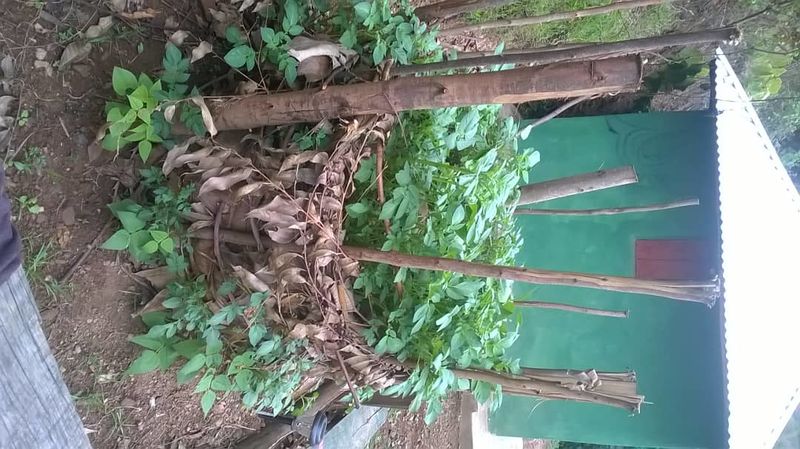
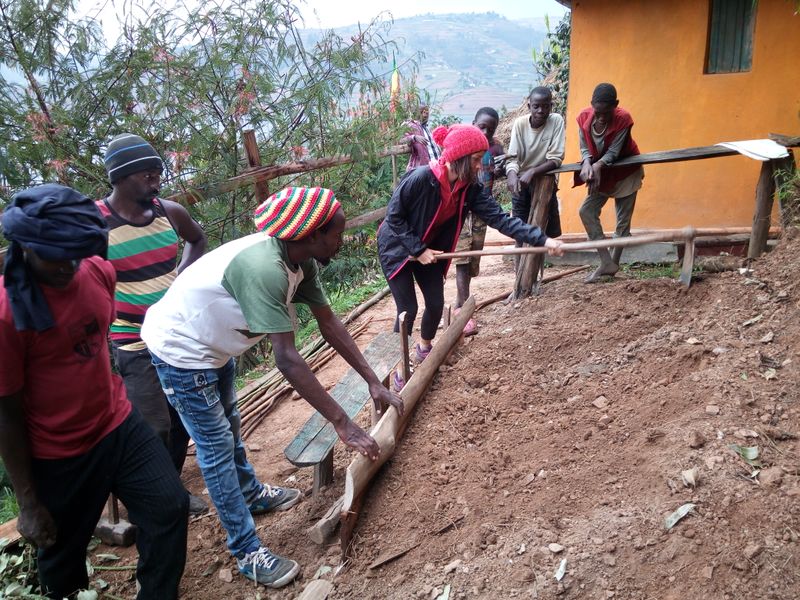
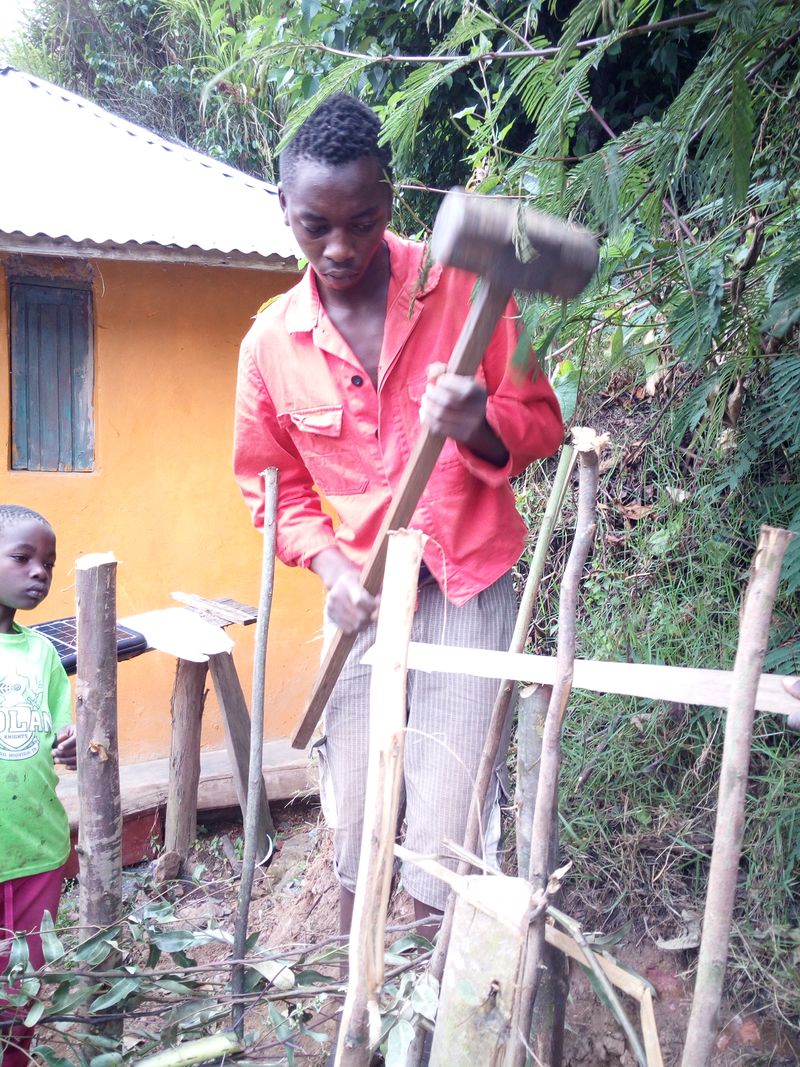
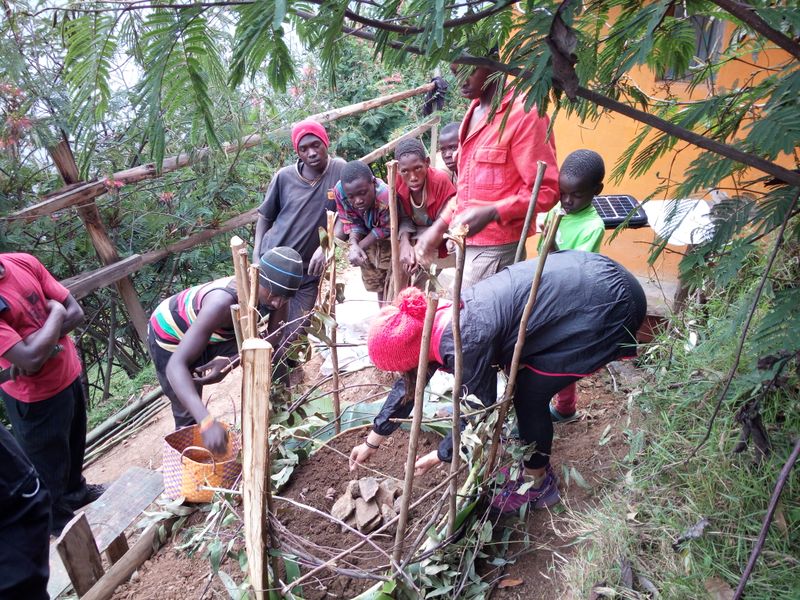
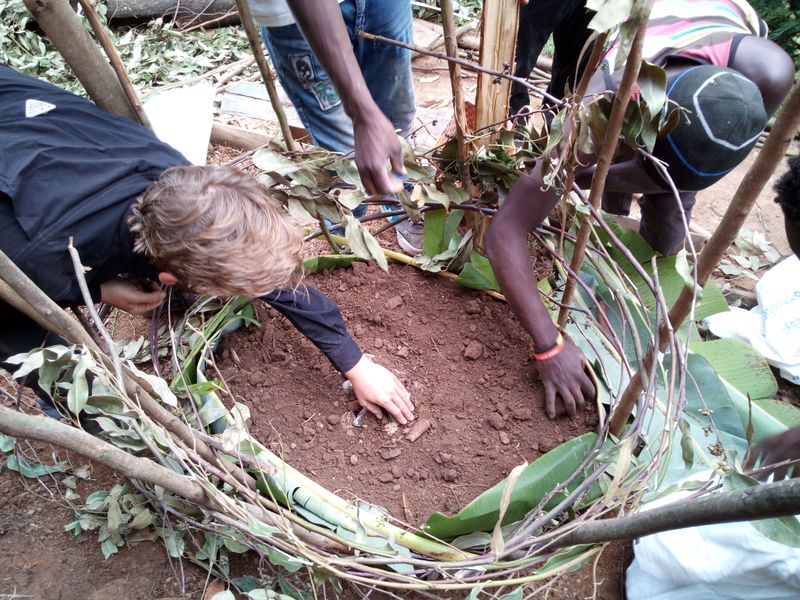
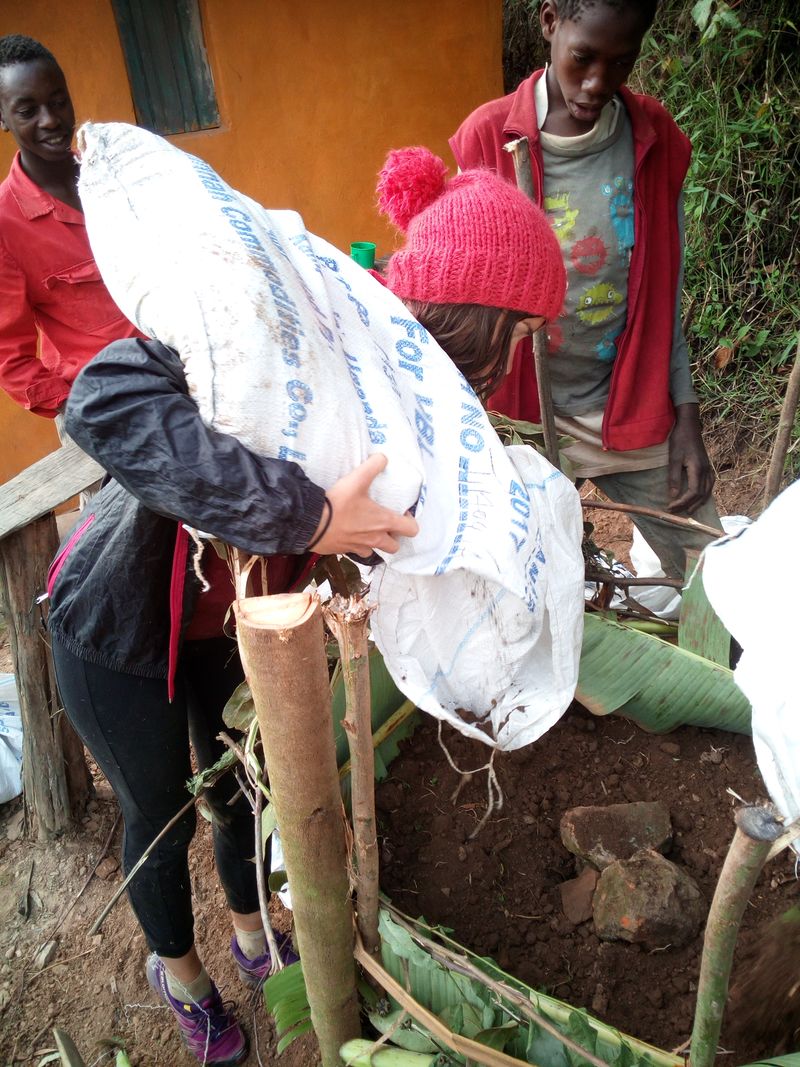
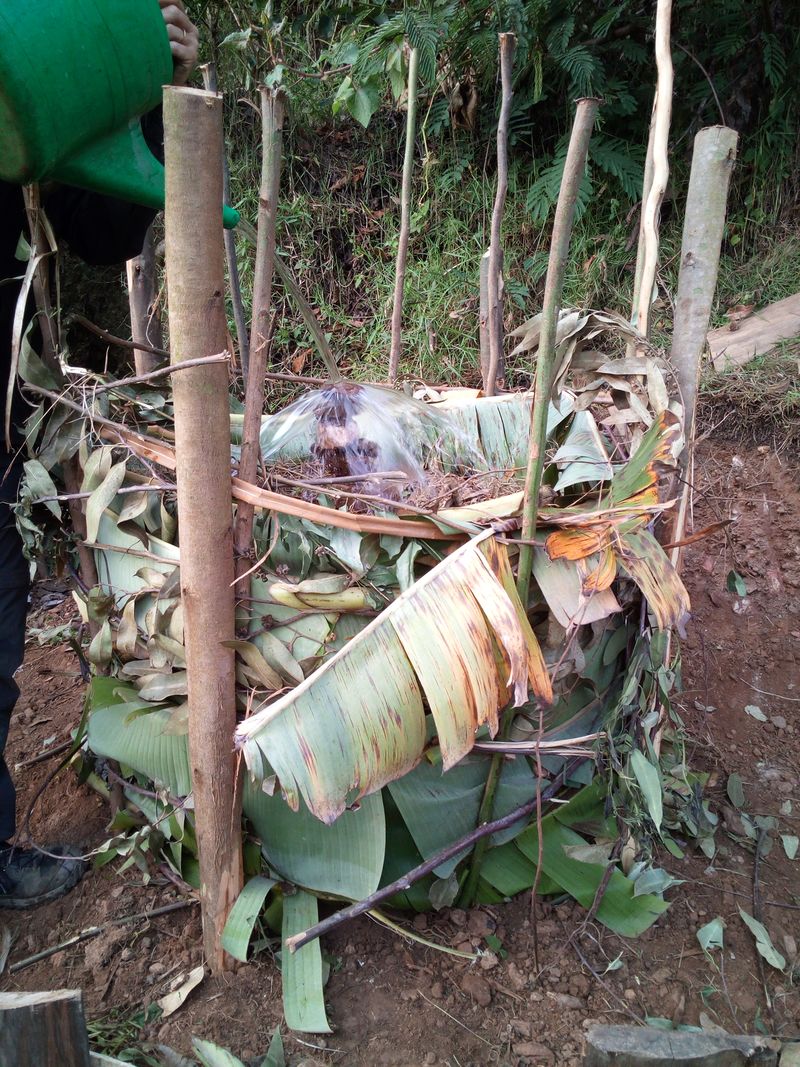
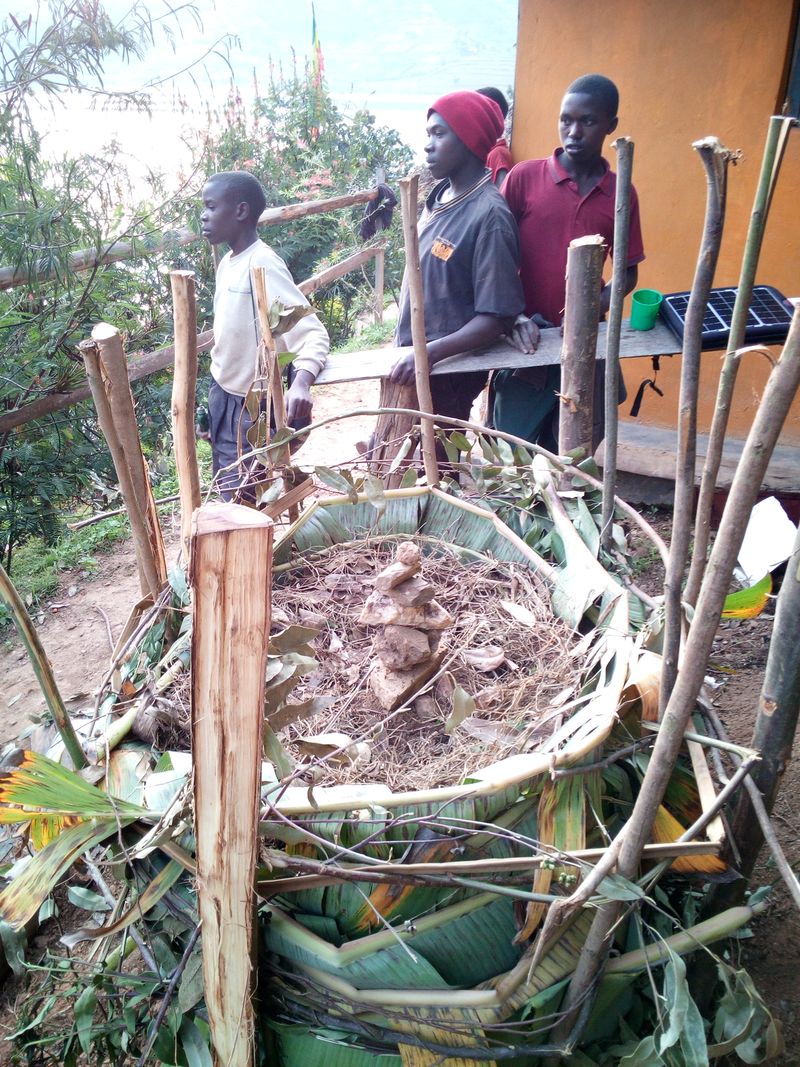
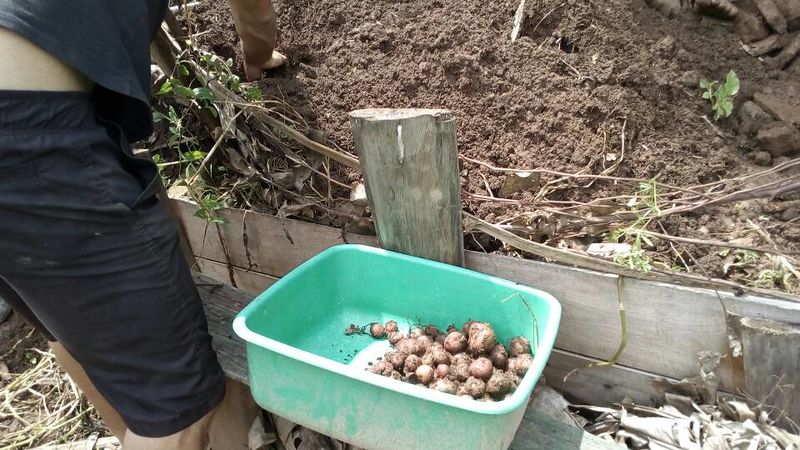
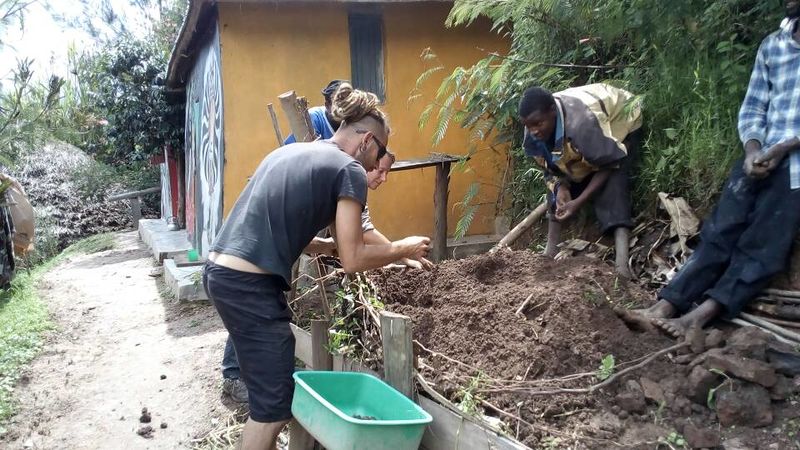
 Français
Français English
English Deutsch
Deutsch Español
Español Italiano
Italiano Português
Português